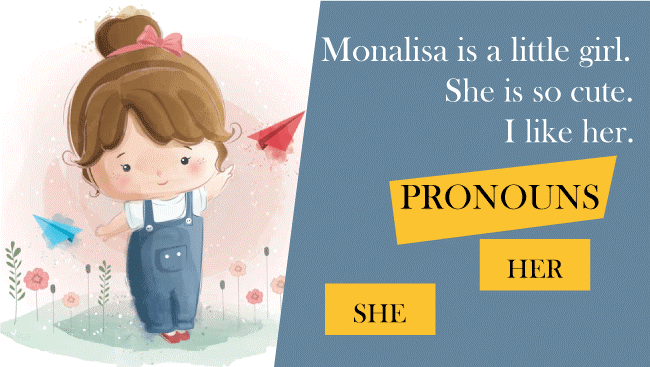Pronoun Definition and ExamplesIntroductionPronouns are an essential part of the English language, serving as a substitute for nouns and allowing speakers to refer to people, objects, or ideas without repeating the same noun repeatedly. Pronouns come in many forms and serve various functions, from referring to specific individuals to expressing general ideas. The use of pronouns is significant in written language, where repeating the same noun over and over again can quickly become repetitive and detract from the overall clarity of the writing. 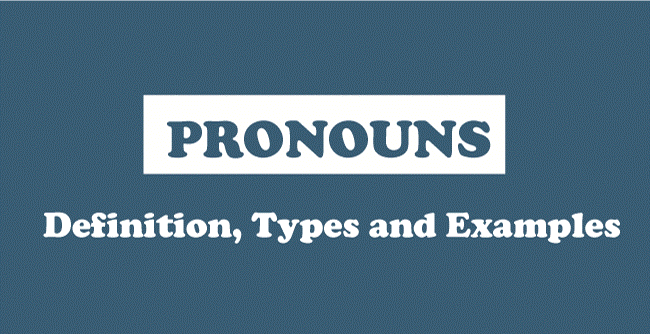
An Overview of Pronoun LinguisticsOne of the most fundamental components of language is pronouns, which enable us to refer to objects, people, and locations in our surroundings. Pronouns are discussed in this article in terms of their linguistic properties and the numerous contexts and languages in which they are used. What Do Pronouns Mean?They act as noun replacements, allowing us to avoid using the same noun repeatedly. The pronoun "he" can be used in place of "John" in the following phrases, as in "He is a good person," for instance, if the first line begins, "John is my friend." Pronoun Variation Due to LinguisticsPronouns can vary significantly between languages, and even within a single language, depending on dialect, register, and other elements. For instance, there may be no difference between formal and informal second-person pronouns in some languages, whereas there may be in others. Pronouns can also take on different forms and have other purposes over time. For instance, using pronouns like "they" and "them" as single pronouns to refer to non-binary people has led to using gender-neutral third-person pronouns in English in recent years. Use of Pronouns in ConversationIn discourse, or how individuals use language to interact with one another, pronouns are very important. They are utilized to bring a conversation together and give it coherence so that speakers and listeners may understand the connections between the things being discussed. The pronoun is a crucial topic of study in linguistics because it provides insight into how language is used to refer to things in the real world. Personal pronouns, for instance, can be used to establish a speaker's point of view and to signify the relationships between speakers and listeners. Reflexive pronouns can also be used to help show that the speaker is referring back to something that has already been spoken. The choice of pronouns can convey details about the speaker's viewpoint, their relationships with the listeners, and how they mentally classify certain entities. 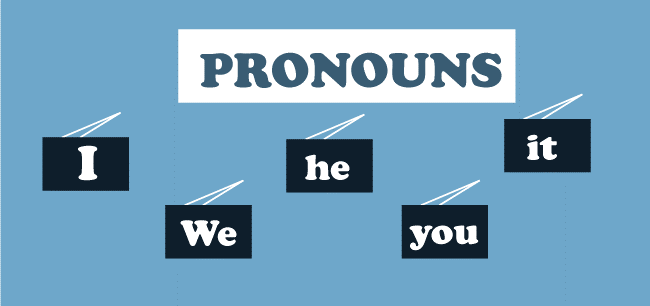
The way that personal pronouns are used to indicate gender is one facet of pronoun usage that linguists are interested in. The pronouns "he" and "she," which are third person singular in many languages, including English, denote the gender of the object being referred to. However, in certain languages, gender is expressed by using pronouns that are either gender-neutral or exclusive to a particular gender category. The use of pronouns to indicate deixis, or the link between the speaker and the things being referred to in terms of time and location, is another crucial topic of study in the linguistics of pronouns. The relative position of entities in time and space is denoted through deictic pronouns like "here" and "there," as well as temporal pronouns like "yesterday" and "tomorrow." The study of pronouns can also provide insight into how languages develop and change through time. For instance, the growing acceptance of the diversity of gender identities and gender expression in recent years can be seen in the increased use of gender-neutral pronouns. The linguistics of pronouns is a fascinating and complex field of research that sheds light on how language is used to refer to things in the real world, to indicate relationships and views, and to reflect social and cultural changes. Pronoun usage can provide details about how power is distributed in communication. The choice of pronoun in many languages can indicate the speakers and the thing being addressed to respective social rank or authority. For instance, the pronoun "you," as opposed to "I," can indicate a difference in power or reverence between the speaker and listener. We can be used as a plural pronoun to convey inclusivity and to develop a sense of community among speakers of various cultures. On the other hand, the exclusive pronoun "we" can be used to exclude people and enforce social boundaries. The correct gender, number, and person matching of a pronoun to its antecedent (the noun or pronoun to which it refers) are referred to as pronoun agreement. It is crucial to adhere to the following rules to arrive at a pronoun agreement:
Types of PronounsGetting into what kind of pronouns we usually use, demonstrative pronouns such as "this" and "that" are used to refer to specific things, while indefinite pronouns such as "someone" and "something" are used to refer to non-specific people or things. Interrogative pronouns such as "who" and "what" are used to ask questions, and relative pronouns such as "that" and "which" are used to connect clauses and provide additional information about a noun or pronoun. Here are some of the most common types of pronouns and examples of how they are used: 1. Personal PronounsPersonal pronouns refer to specific people, places, or things. They include first-person pronouns (such as "I," "me," and "mine"), second-person pronouns (such as "you" and "yours"), and third-person pronouns (such as "he," "she," "it," "him," "her," "they," "them," and "theirs"). 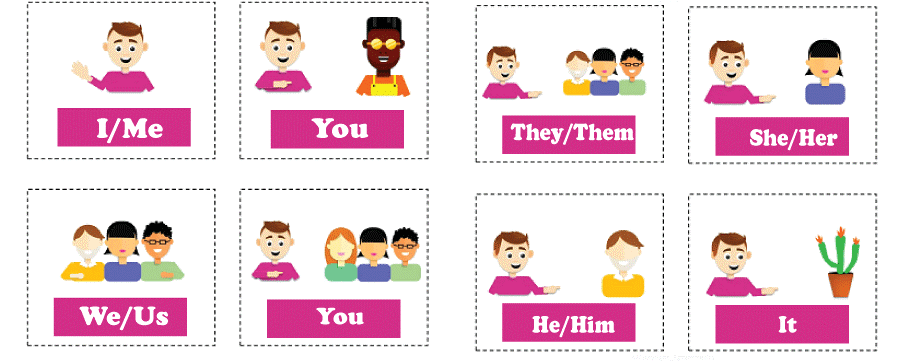
Examples: I walked to the store. You need to finish your homework. He is the best player on the team. 2. Possessive PronounsPossessive pronouns show ownership or possession of something. They include "mine," "yours," "hers," "his," "its," "ours," and "theirs." Examples: This book is mine. The dog is theirs. The coat is hers. 3. Reflexive PronounsThey include "me," "yourself," "himself," "herself," "itself," "ourselves," and "ourselves." Examples I hurt myself. She prepared herself for the test. They worked on the project themselves. 4. Intensive PronounsIntensive pronouns are used to emphasize a sentence's subject. They are formed by adding "-self" to reflexive pronouns. Examples I did it myself. She made the cake. They built the house themselves. 5. Demonstrative PronounsDemonstrative pronouns are used to refer to specific people, places, or things and include "this," "that," "these," and "those." Examples This is my favorite book. These are my friends. That is a great idea. 6. Indefinite PronounsThey include "someone," "anyone," "something," "everything," "nothing," and "someone." Examples Someone left their phone on the table. Anything is possible. Everyone loves pizza. 7. Interrogative PronounsInterrogative pronouns are used to ask questions and include "who," "whom," "whose," "what," and "which." Examples Who is coming to the party? What do you want to eat? Which one do you prefer? 8. Relative PronounsRelative pronouns are used to connect clauses and include "that," "which," "who," "whom," and "whose." Examples The very long movie finally ended. The book, whose cover was torn, was still readable. The person who won the award was amazed. 9. Dummy PronounsExpletive pronouns, commonly called dummy pronouns, are words added to a sentence merely to fill it out. They frequently appear at the start of a sentence, serve grammatical functions, and maintain sentence structure. It and there are the two dummy pronouns that are most commonly employed in English. For instance, It is pouring rain. (In this statement, the dummy pronoun "it" is utilized to keep the sentence's form but adds no different meaning). "Six apples are on the table." (In this line, the dummy pronoun "there" is used to denote the location of the word "apples"). Dummy pronouns are used to make statements grammatically correct even when they don't refer to any particular word or concept. They frequently act as stand-ins for more significant subjects in sentence structures where the subject is ambiguous or inconsequential. Rules For Using PronounsThe relationship between a pronoun and the noun or other pronoun to which it refers, also known as its antecedent, is referred to as the pronoun reference. It is crucial to adhere to the following rules to establish clear pronoun references:
Pronouns Vs. DeterminersIn English, both pronouns and determiners refer to nouns but have different functions. Without repeating the noun, pronouns refer to a noun or a collection of nouns that have been mentioned before or are presumed to be well-known. On the other hand, determiners are used before a noun to show where the noun is employed in the phrase. Determiners include words like "the," "a," "an," "these," and "those." In contrast, determiners specify or determine the noun they come before, whereas pronouns substitute nouns. Pronouns Vs. NounsIn sentences, pronouns and nouns are two distinct word categories that have different functions in the English language. Nouns provide names to individuals, groups, objects, or ideas. Nouns include things like "dog," "city," "idea," and "John." Nouns can relate to actual objects or abstract concepts (referring to non-physical objects). They serve as noun replacements and reduce verbal and written repetition. Pronouns can also refer to a noun that has already been mentioned, an overall concept, or an imagined individual or object. In conclusion, pronouns refer to things specified by nouns or to a generic idea, whereas nouns name specific objects. ConclusionIn conclusion, pronouns play a vital role in the English language, allowing speakers to refer to people, places, and things without repeating the same nouns repeatedly. Knowing pronouns is essential, whether speaking in everyday conversation or writing a formal essay. Understanding the different types of pronouns and their functions is integral to learning English and communicating effectively. In addition to replacing nouns, pronouns can serve several other vital functions in language. For example, personal pronouns can indicate the speaker or writer's perspective, with first-person pronouns such as "I" and "we" indicating the speaker or writer's perspective, and third-person pronouns such as "he," "she," and "it" indicating a more objective perspective. Possessive pronouns such as "mine" and "yours" can indicate ownership, while reflexive pronouns such as "myself" and "yourself" are used to indicate that the subject of a sentence is also the object. 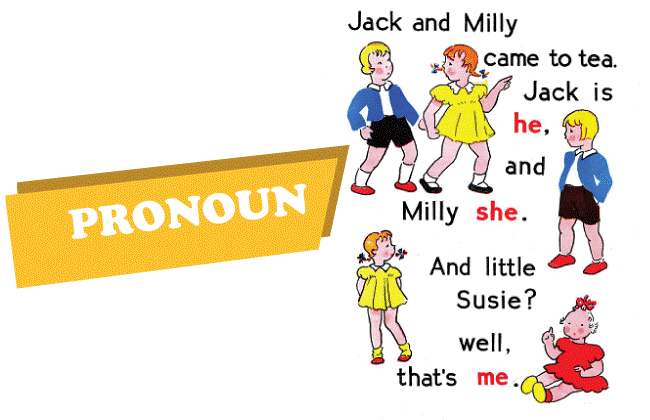
Another critical aspect of pronoun usage is an agreement, which refers to how pronouns must match the nouns they are replacing in terms of gender, number, and person. For example, third-person singular pronouns such as "he" and "she" must agree with the gender of the person they are referring to, while first and second-person pronouns such as "I" and "you" must match the personality of the speaker or writer. An agreement can be a complex issue in some languages. Still, it is usually straightforward in English, with only a few exceptions, such as using "they" as a gender-neutral pronoun. Finally, it is worth noting that the use of pronouns can vary greatly depending on cultural and linguistic context. In some cultures, for example, using first-person pronouns is considered more informal or less appropriate in specific contexts, and others, it is considered more direct and honest. Similarly, personal pronouns can vary significantly in different writing styles, with formal writing often avoiding using first-person pronouns in favor of a more objective perspective. Therefore, pronouns are essential to any language's grammar, serving various functions, from replacing nouns to indicating the speaker or writer's perspective and from expressing ownership to asking questions. Understanding the different types of pronouns, their procedures, and the rules of agreement is essential to mastering English and communicating effectively in various contexts.
Next TopicSmall Company Definition
|
 For Videos Join Our Youtube Channel: Join Now
For Videos Join Our Youtube Channel: Join Now
Feedback
- Send your Feedback to [email protected]
Help Others, Please Share





